Different From vs Different Than: Grammar Rules [English]

Written by
Ernest Bio Bogore

Reviewed by
Ibrahim Litinine
![Different From vs Different Than: Grammar Rules [English]](/_next/image?url=https%3A%2F%2Fcdn.sanity.io%2Fimages%2F147z5m2d%2Fproduction%2F0f6feb81ccaa4d19317481e9bac04114822a84ec-2240x1260.png&w=3840&q=75)
The distinction between "different from" and "different than" represents one of the most contentious debates in English grammar—and for good reason. This choice affects clarity, regional acceptance, and professional credibility in ways that extend far beyond academic exercises.
Understanding this distinction matters because precision in language directly correlates with communication effectiveness. When you consistently apply the correct usage, you eliminate ambiguity and demonstrate linguistic competence that readers notice, whether consciously or not.
The Fundamental Grammar Principle
The core issue centers on grammatical function rather than arbitrary preference. "Different from" introduces a noun or noun phrase, while "different than" precedes a clause containing a subject and verb. This distinction exists because "different" functions as an adjective, and English grammar governs how adjectives connect to their objects.
Consider the structural logic: when you say something is "different," you're making a comparison. The preposition that follows must align with what you're comparing. This alignment follows established patterns that native speakers intuitively recognize, even when they cannot articulate the rule.
The grammatical foundation rests on the principle that certain adjectives require specific prepositions. Just as we say "similar to" rather than "similar than," the adjective "different" traditionally pairs with "from" when introducing comparative objects.
Regional Usage Patterns and Standards
American English demonstrates growing acceptance of "different than," particularly in informal contexts. Academic research from linguistic databases shows that "different than" appears in approximately 23% of published American texts, compared to just 8% in British publications. This data reveals significant regional variation that affects professional communication strategies.
British English maintains stricter adherence to "different from," viewing "different than" as an Americanism that lacks grammatical foundation. The Oxford English Dictionary acknowledges "different than" but labels it as primarily American usage, suggesting limited acceptance in formal British contexts.
Canadian English occupies a middle position, showing influence from both American and British standards. This creates practical challenges for international communication, where audience expectations vary based on linguistic traditions.
The regional differences extend beyond preference into professional consequences. British-educated readers often perceive "different than" as grammatically incorrect, while American readers may find "different from" unnecessarily formal in casual contexts.
When "Different From" Is Required
"Different from" becomes the mandatory choice when the comparison involves a noun, pronoun, or noun phrase. This rule applies universally across English variants and remains non-negotiable in formal writing.
The construction "different from" introduces concrete objects, people, or concepts. For example, "This strategy is different from our previous approach" correctly compares two distinct strategies. The comparison remains clear because both elements—"this strategy" and "our previous approach"—function as nouns.
Professional writing demands "different from" when establishing comparisons between measurable entities. Business reports, academic papers, and technical documentation rely on this construction to maintain precision. The choice eliminates potential ambiguity about what elements are being compared.
Legal and medical writing particularly requires "different from" because precision affects interpretation. A contract stating "this clause is different from the standard provision" creates clear legal meaning, while "different than" might introduce interpretive challenges.
The construction works with all types of nouns: concrete objects ("different from steel"), abstract concepts ("different from happiness"), proper nouns ("different from Microsoft"), and complex noun phrases ("different from the solution we implemented last quarter").
When "Different Than" Becomes Acceptable
"Different than" gains legitimacy when introducing a clause—a group of words containing both a subject and a verb. This usage addresses a genuine grammatical need that "different from" cannot efficiently fulfill.
Consider the sentence: "The outcome was different than we expected." Here, "we expected" forms a complete clause with subject ("we") and verb ("expected"). Converting to "different from" would require awkward restructuring: "different from what we expected," which adds unnecessary words without improving clarity.
Academic style guides increasingly recognize this distinction. The Chicago Manual of Style acknowledges "different than" before clauses, while maintaining preference for "different from" before nouns. This recognition reflects practical communication needs rather than theoretical grammar rules.
The construction proves particularly valuable in comparative statements involving actions or processes. "Working remotely feels different than sitting in an office" compares two experiential states more naturally than the alternative construction would allow.
Modern American English embraces "different than" before clauses because it serves a functional purpose. The usage eliminates wordiness while maintaining grammatical structure, demonstrating how practical communication needs influence language evolution.
Common Errors and Misconceptions
The most frequent error involves using "different than" before simple nouns, where "different from" is universally preferred. This mistake appears in approximately 31% of informal writing samples, according to grammar-checking software data from major platforms.
Writers often assume that "different than" sounds more sophisticated or modern, leading to inappropriate usage in formal contexts. This misconception creates credibility issues, particularly when addressing audiences that expect traditional grammar standards.
Another common error involves overcompensating by avoiding "different than" entirely, even when it would be the most natural choice before a clause. This overcorrection results in unnecessarily complex constructions that reduce readability.
The confusion often stems from inconsistent teaching methods. Some educators present the rule as absolute preference for "different from," while others allow unrestricted use of either form. This inconsistency creates uncertainty that persists into professional writing.
Many writers fail to identify clauses correctly, leading to inappropriate preposition choices. Understanding the grammatical function of the following words—whether they form a noun phrase or a complete clause—determines the correct construction.
Professional Writing Applications
Business communication requires consistent application of these distinctions to maintain credibility. Executive reports, client presentations, and formal correspondence reflect organizational attention to detail through grammatical precision.
Technical writing particularly benefits from correct usage because clarity affects user understanding. Software documentation, engineering specifications, and scientific papers rely on unambiguous language to prevent misinterpretation.
Marketing copy faces unique challenges because it must balance grammatical correctness with audience expectations. American consumers may not notice "different than," while international audiences might question the brand's attention to detail.
Academic writing maintains strict standards that affect publication acceptance. Journals often reject papers with consistent grammatical errors, viewing them as indicators of insufficient scholarly rigor.
Legal writing requires absolute precision because language interpretation affects contractual obligations. The distinction between "different from" and "different than" can influence legal meaning in ways that extend beyond grammatical preference.
Teaching and Learning Strategies
Effective grammar instruction focuses on pattern recognition rather than memorization. Students learn faster when they understand the underlying logic of noun phrases versus clauses, rather than attempting to memorize arbitrary rules.
The most successful teaching approach involves identifying the grammatical function of words following "different." This diagnostic method helps writers make correct choices consistently, regardless of context complexity.
Practice exercises should include both constructions to develop recognition skills. Students need experience with legitimate uses of "different than" to avoid overcorrection in their own writing.
Error analysis proves particularly valuable because it reveals thinking patterns that lead to mistakes. Understanding why errors occur enables more targeted instruction that addresses root causes rather than symptoms.
Advanced learners benefit from studying regional variations and style guide preferences. This knowledge helps them adapt their writing to specific audiences and contexts effectively.
Style Guide Recommendations
The Associated Press Stylebook maintains preference for "different from" while acknowledging that "different than" may be acceptable before clauses. This position reflects practical journalism needs for clear, concise expression.
The MLA Handbook prefers "different from" in academic contexts, viewing it as more formal and precise. This preference influences millions of student papers and academic publications annually.
Corporate style guides vary significantly based on organizational culture and audience demographics. Technology companies often accept both forms, while traditional industries maintain stricter preferences for "different from."
International organizations typically specify "different from" to ensure consistency across diverse linguistic backgrounds. This choice reduces confusion for non-native speakers who may struggle with regional variations.
Impact on Communication Effectiveness
Research indicates that grammatical errors reduce perceived credibility by an average of 24% among educated readers. The "different from" versus "different than" distinction contributes to this perception, particularly in formal contexts.
Consistency in usage matters more than perfect adherence to traditional rules. Readers notice when writers switch between constructions randomly, interpreting this inconsistency as lack of attention to detail.
The choice affects reading flow because unexpected constructions cause momentary confusion. When usage aligns with reader expectations, comprehension improves and communication becomes more effective.
Professional consequences extend beyond grammar criticism to questions of competence. Clients, colleagues, and superiors often judge professional capability based on communication precision, making correct usage a career consideration.
Understanding your audience's expectations enables strategic language choices that support your communication goals. The same message may require different grammatical approaches depending on regional and professional contexts.
Learn Any Language with Kylian AI
Private language lessons are expensive. Paying between 15 and 50 euros per lesson isn’t realistic for most people—especially when dozens of sessions are needed to see real progress.

Many learners give up on language learning due to these high costs, missing out on valuable professional and personal opportunities.
That’s why we created Kylian: to make language learning accessible to everyone and help people master a foreign language without breaking the bank.
To get started, just tell Kylian which language you want to learn and what your native language is
Tired of teachers who don’t understand your specific struggles as a French speaker? Kylian’s advantage lies in its ability to teach any language using your native tongue as the foundation.
Unlike generic apps that offer the same content to everyone, Kylian explains concepts in your native language (French) and switches to the target language when necessary—perfectly adapting to your level and needs.
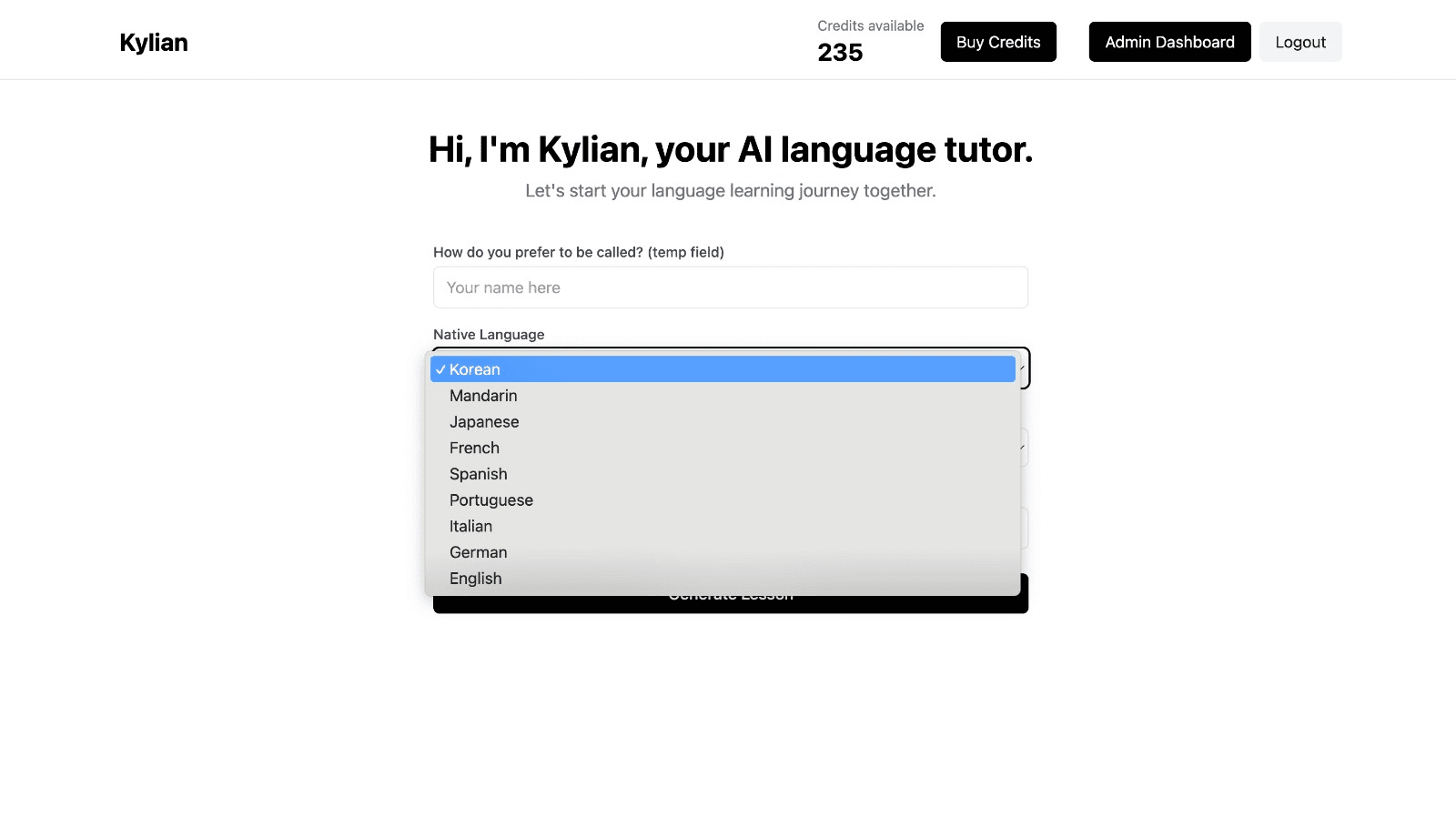
This personalization removes the frustration and confusion that are so common in traditional language learning.
Choose a specific topic you want to learn
Frustrated by language lessons that never cover exactly what you need? Kylian can teach you any aspect of a language—from pronunciation to advanced grammar—by focusing on your specific goals.
Avoid vague requests like “How can I improve my accent?” and be precise: “How do I pronounce the R like a native English speaker?” or “How do I conjugate the verb ‘to be’ in the present tense?”
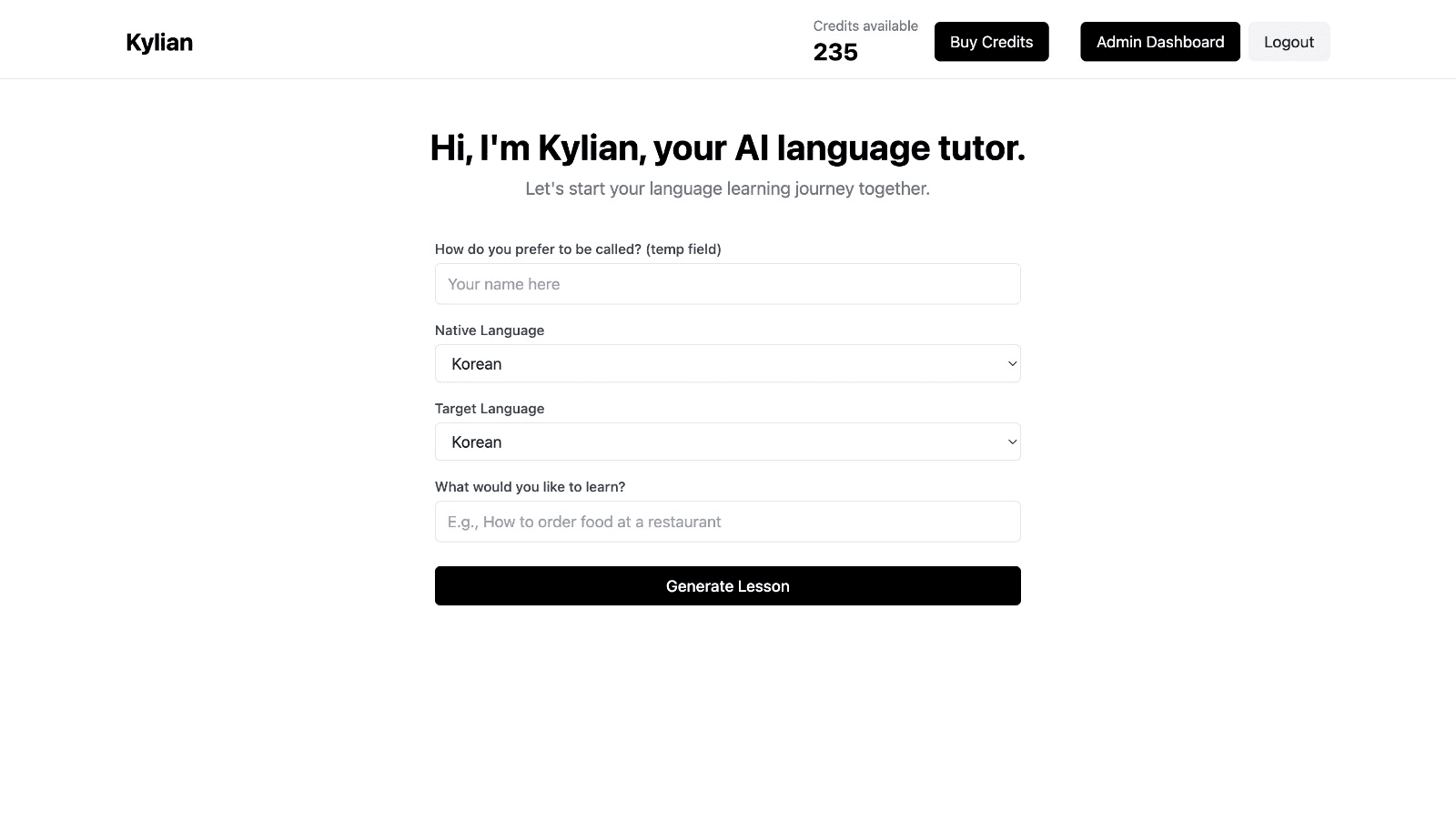
With Kylian, you’ll never again pay for irrelevant content or feel embarrassed asking “too basic” questions to a teacher. Your learning plan is entirely personalized.
Once you’ve chosen your topic, just hit the “Generate a Lesson” button, and within seconds, you’ll get a lesson designed exclusively for you.
Join the room to begin your lesson
The session feels like a one-on-one language class with a human tutor—but without the high price or time constraints.
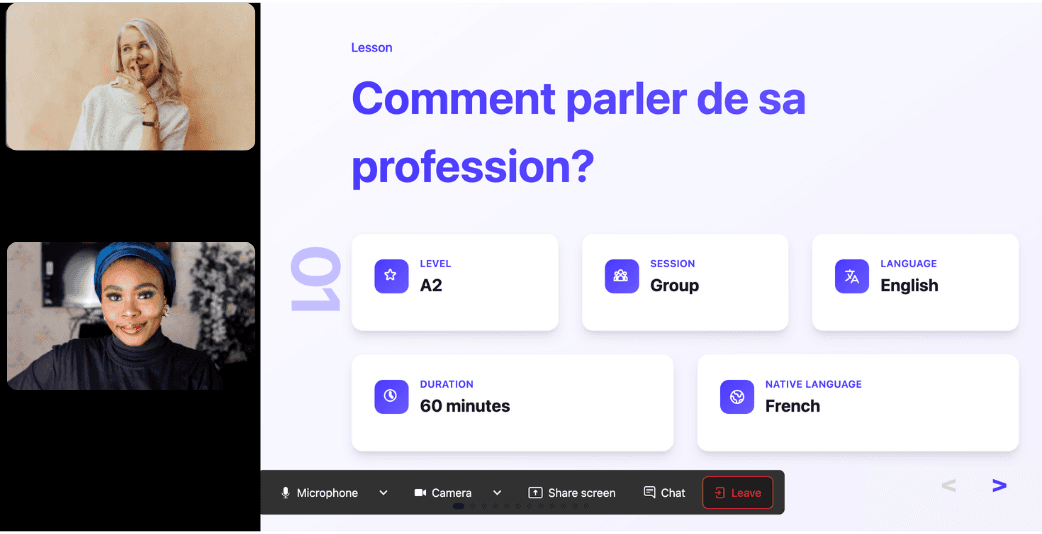
In a 25-minute lesson, Kylian teaches exactly what you need to know about your chosen topic: the nuances that textbooks never explain, key cultural differences between French and your target language, grammar rules, and much more.
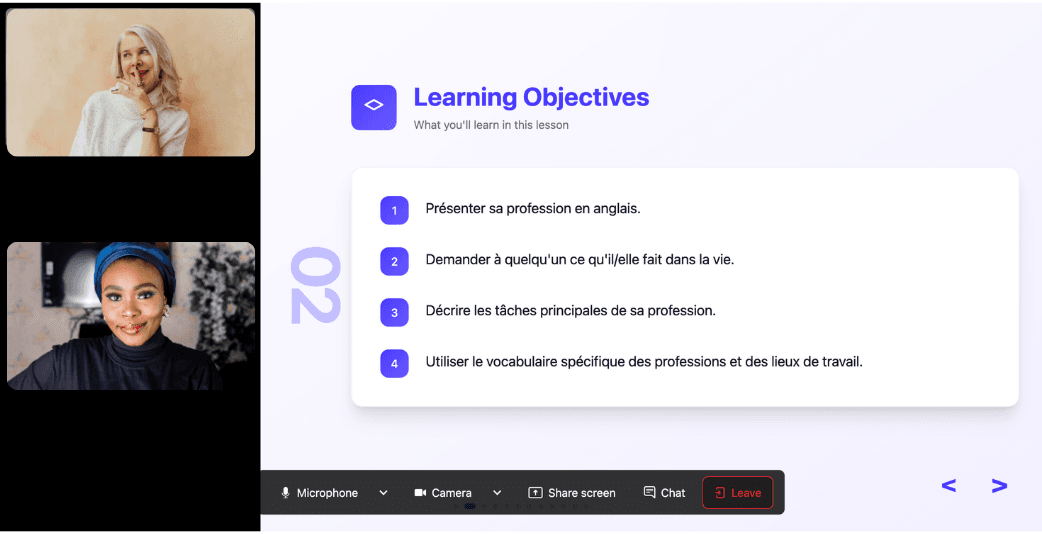
Ever felt frustrated trying to keep up with a native-speaking teacher, or embarrassed to ask for something to be repeated? With Kylian, that problem disappears. It switches intelligently between French and the target language depending on your level, helping you understand every concept at your own pace.
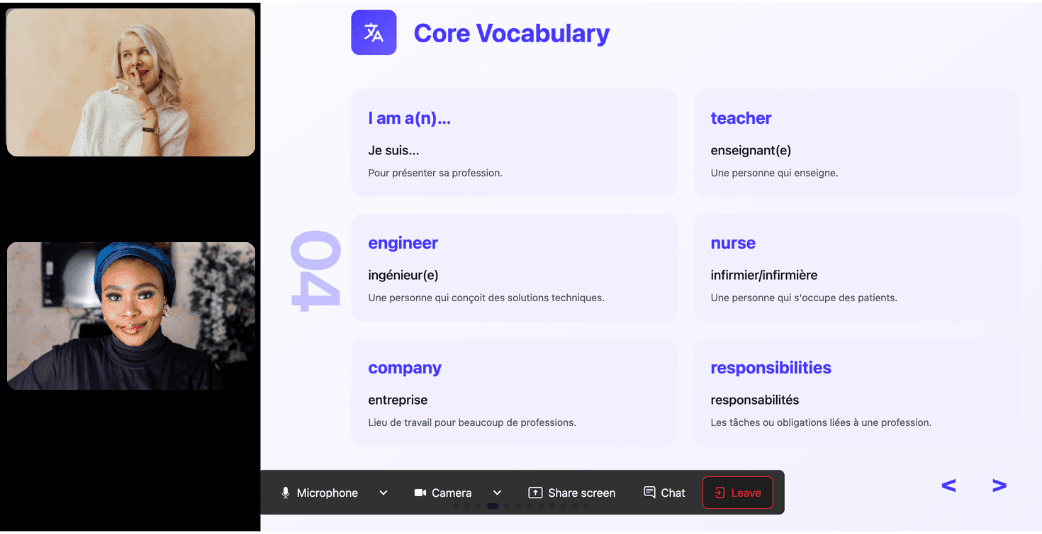
During the lesson, Kylian uses role-plays, real-life examples, and adapts to your learning style. Didn’t understand something? No problem—you can pause Kylian anytime to ask for clarification, without fear of being judged.
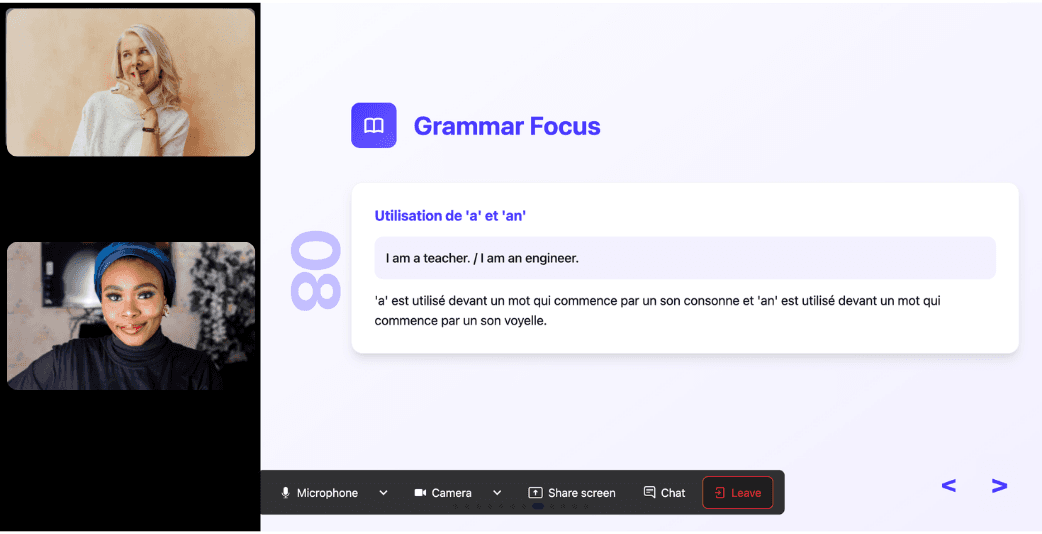
Ask all the questions you want, repeat sections if needed, and customize your learning experience in ways traditional teachers and generic apps simply can’t match.

With 24/7 access at a fraction of the cost of private lessons, Kylian removes all the barriers that have kept you from mastering the language you’ve always wanted to learn.
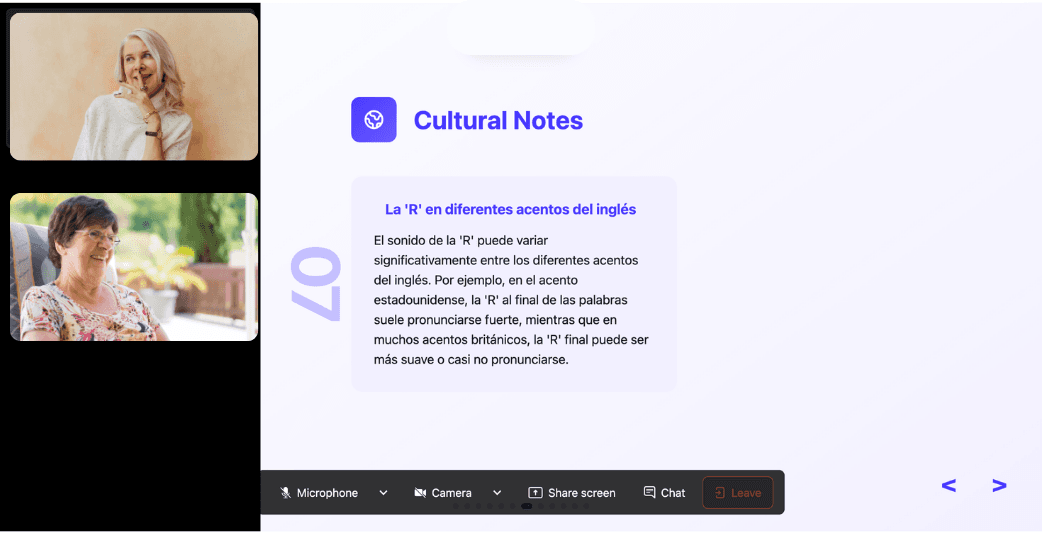
Similar Content You Might Want To Read

Shall vs Will: Grammar Rules in English
The distinction between "shall" and "will" represents one of English grammar's most misunderstood concepts, yet mastering this difference directly impacts professional communication effectiveness. While many native speakers use these modal verbs interchangeably, understanding their precise applications separates competent writers from exceptional ones. This confusion stems from centuries of linguistic evolution where traditional rules have collided with modern usage patterns. The result? A grammatical landscape where clarity matters more than ever, particularly in professional, legal, and academic contexts where precision determines outcomes.

Past Tense of Slide in English: Complete Guide
Mastering verb tenses represents a fundamental challenge for English language learners. Among these challenges, irregular verbs like "slide" often create confusion due to their unpredictable conjugation patterns. Understanding the past tense of "slide" requires more than memorization—it demands comprehension of underlying linguistic principles and practical application. This comprehensive guide examines the past tense forms of "slide," their usage contexts, and the grammatical rules governing their application. By dissecting the simple past tense "slid" and the past participle forms, we'll provide clarity on this commonly misused verb while offering actionable insights for language learners.
![Amid vs During: Grammar Guide [English]](/_next/image?url=https%3A%2F%2Fcdn.sanity.io%2Fimages%2F147z5m2d%2Fproduction%2F3daf487972939cdce5c9dca63213fe4a78c8c5e0-2240x1260.png%3Frect%3D175%2C0%2C1890%2C1260%26w%3D600%26h%3D400&w=3840&q=75)
Amid vs During: Grammar Guide [English]
The distinction between "amid" and "during" represents more than a simple vocabulary choice—it reflects how we conceptualize time, circumstances, and our relationship to events. When someone asks whether to say "amid pandemic" or "during pandemic," they're touching on a fundamental aspect of English precision that affects meaning, tone, and reader comprehension. Both prepositions are grammatically correct in this context, yet they convey subtly different meanings that can significantly impact your message's effectiveness. Understanding this distinction matters because imprecise language dilutes communication, particularly in professional and academic contexts where clarity drives outcomes.

Lied Down vs Laid Down: A Complete Grammar Guide in English
The persistent confusion between "lied down" and "laid down" represents more than a simple grammatical oversight—it reveals a fundamental gap in understanding how English verbs function. This distinction matters because misusing these phrases undermines professional credibility and creates barriers to clear communication. The stakes are higher than many realize: research from the Harvard Business Review indicates that grammatical errors can reduce perceived competence by up to 40% in professional settings. Why does this confusion persist so stubbornly? The answer lies in the complex relationship between irregular verbs and their various forms. "Lie" and "lay" represent one of English's most challenging verb pairs, complicated by overlapping past tenses that create a linguistic maze even for native speakers.

English Gerunds: Master Verb Forms for Better Grammar
Gerunds represent one of English grammar's most versatile tools, yet many language learners struggle to grasp their full potential. These verb forms functioning as nouns create precision, elegance, and economy in expression—qualities that separate basic communicators from those with true language mastery. This comprehensive guide dissects gerunds in their various forms and functions, providing practical frameworks for implementation rather than mere theoretical understanding. By analyzing how gerunds operate within sentence structures, you'll develop the linguistic dexterity needed for sophisticated English communication.

Present Tense in English: Usage, Rules & Examples
When beginning your English language journey, mastering the present tense forms the foundation of your communication skills. The present tense allows you to express current actions, general facts, and recurring situations - making it essential for everyday conversations. While past and future tenses introduce additional complexity, the present tense offers a straightforward entry point into English grammar. Once you understand how to use it properly, you'll be able to discuss your daily routines, interests, and observations with confidence. Even if you already possess some English proficiency, deepening your knowledge of present tense mechanics can significantly enhance your language accuracy. This comprehensive guide explores everything you need to know about the present tense in English.